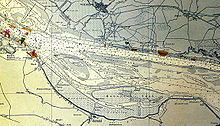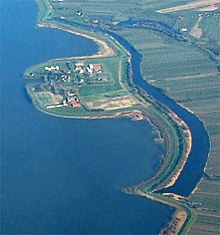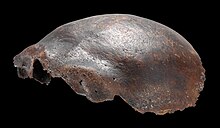Hahnöfersand
|
Hahnöfersand
|
||
|
Aerial view of Hahnöfersand |
||
| location | North of Buxtehude , Stade district , Lower Saxony | |
| surface | 105 ha | |
| Identifier | NSG LÜ 286 | |
| FFH area | 105 ha | |
| Geographical location | 53 ° 33 ' N , 9 ° 43' E | |
|
|
||
| Sea level | from 0 m to 1 m | |
| Setup date | October 31, 2008 | |
| administration | NLWKN | |
Hahnöfersand is an Elbe island in the Borstel district of the Jork municipality . The island is located in Lower Saxony and has been a nature reserve since 2008 . The Hahnöfersand correctional facility of the Free and Hanseatic City of Hamburg has also been located on it for more than a century .
location
Hahnöfersand is one of the marshland islands in the Lower Elbe on the banks of the Elbe in Lower Saxony in the immediate vicinity of the Altes Land and is roughly opposite the Schleswig-Holstein town of Wedel . The next town in Lower Saxony is Jork, 5 kilometers away . Today's peninsula is about 1100 meters long, up to 700 meters wide and has an area of about 1.6 km²; Hahnöfersand was originally a 3.5 km² island, but large areas were converted into Elbe watts .
history
The origin of the name Hahnöfersand cannot be exactly reconstructed. Names like Hansodt-Sand , Hannoversand , Hanensand , Hanenhöygersand or Hanöfersand appear in relation to the island. Hansodt-Sand could be a name of former owners. A folk etymological explanation says that in a storm surge only the top of the church tower would have looked out of the water if it had a cock as its tip and the name "Hahn öfer Sand" ("cock above the sand") was derived from this.
Hahnöfersand was originally connected to the mainland (the "old country") and was probably separated during the Cäcilienflut in November 1412 and thus became an island on the Elbe . Hahnöfersand belongs to the state of Lower Saxony under constitutional law . In 1902 it was acquired by the Hamburg Senate for the city of Hamburg from the Prussian domain administration for 250,000 Reichsmarks . Initially, the island served as a repository for the sand dredged from the port of Hamburg . That is why the island is still around eight meters higher than the level of the "Old Land". There were also considerations of building a zeppelin port or an artillery firing range on the island .
At last Hahnöfersand was separated from the south bank of the Elbe by a narrow branch, the Borsteler Nebenelbe . The embankment of the Elbe across the entrance and exit of this arm of the water ended Hahnöfersand's status as an island in the 1970s.
Prison island
In 1911 the island was handed over to the Hamburg prison administration and in 1913 the first prisoners were brought to Hahnöfersand. At that time they lived in unpaved houses and had the task of making the soil usable by applying silt and clay . In March 1915 this work was continued by 1,200 Russian prisoners of war. 77 prisoners died at that time, probably due to an epidemic .
The juvenile detention center was founded on June 20, 1920. From 1940, the prisoners were transferred to other institutions in Hamburg and the area was used for a flak unit to protect industry on the then Elbe island of Finkenwerder . Immediately after the end of the Second World War , the island became a prison for teenagers and young adults again.
In 1976 Hahnöfersand was diked as part of flood protection measures and connected to the mainland with a dam and a road.
In 1997, a closed prison for women was added to the prison complex in two separate buildings.
Nature reserve
The Hahnöfersand was designated as a nature reserve in 2008 because of its near-natural mudflats and marshes. The State Office for Water Management, Coastal Protection and Nature Conservation, as the responsible authority, formulates: “The area is particularly characterized by changes due to the dynamic processes in the tidal Elbe such as tides, headwater runoff, sedimentation, erosion, storm surges and drifting ice, as well as by its quality as a habitat and habitat rare and endangered animal and plant species of the Elbe estuary . The protection purpose is the preservation and development of the functionality of the habitats of the Elbe estuary with freshwater-influenced mudflats, shallow water zones, tidal reeds and tidal floodplain forests. ”In December 2018, the area merged into the new designated nature reserve“ Elbe and Islands ”.
As a compensatory measure for the partial filling in of the Mühlenberger Loch to expand the Airbus site, the eastern and western parts of the island were artificially converted into mud flats by erosion . These are well received by the teals , but not by the endangered shovelers .
Others
The skull of Hahnöfersand found on the island was dated by Reiner Protsch to an age of 36,000 years and assigned to the Neanderthals . When it was found that a large number of dates of the dating laboratory he has headed since 1973 were completely flawed, an independent re-dating became necessary. However, tests in a carbon-14 laboratory in Oxford only showed an age of no more than 7,500 years.
The island has a cemetery which also houses 77 Russian prisoners of war who died of scurvy and dysentery during the First World War . There is also a museum. Due to their location within the prison complex, the cemetery and museum are not accessible to the public.
literature
- Kurt Stypmann: Hahnöfersand - The island through the ages .
- Offense number 69 . In: The time . No. 29/1998.
- District of Stade, Nature Conservation Office (Ed.): Hahnöfersand - protected realm for shovelers and co.?. In: Environment in a circle. 2009, pp. 4–5 ( PDF file , 1.7 MB).
Web links
- Hahnöfersand Museum (private site)
Individual evidence
- ^ Ohle: Hahnöfersand , p. 3.
- ^ Ohle: Hahnöfersand , p. 4
- ^ Rarities in the museum on Hahnöfersand. In: Die Welt , August 7, 2001
- ^ Ohle: Hahnöfersand , p. 3
- ^ Rarities in the museum on Hahnöfersand , welt.de of August 7, 2001.
- ^ "Hahnöfersand" nature reserve in the database of the Lower Saxony State Office for Water Management, Coastal and Nature Conservation (NLWKN)
- ↑ Matthias Schulz: I make the rules . In: Der Spiegel . No. 34 , 2004, pp. 128 ff . ( online ).
- ^ Rarities in the museum on Hahnöfersand , welt.de of August 7, 2001.
- ↑ Edgar S. Hasse: Hamburg's prison island. In: "Hamburger Abendblatt", August 21, 2017, p. 12.
Coordinates: 53 ° 33 ' N , 9 ° 43' E







